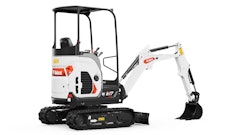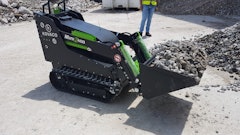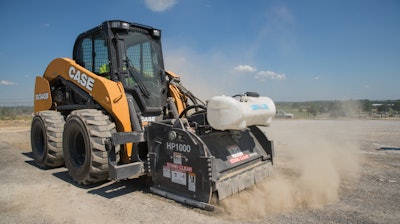
Universal skid-steer and compact track loader (CTL) couplers allow you to mate an attachment with any brand of equipment. But they can also allow size mismatches between the carrier unit and attachment. Improper attachment use can lead to accidents, downtime and unnecessary expenses.
Perhaps the most important consideration is the physical size of the attachment and how it sizes up to the capabilities of the loader.
“As far as the attachment fitting to the machine, we always recommend that the customer has an awareness of what the machine capabilities are as well as the attachment capabilities,” says Mike Fitzgerald, loader product specialist, Bobcat. “On the machine, you have the rated operating capacity. You want to take into account what that attachment might weigh. We have an approved attachment list for each of the different sizes of machines.”
Attachments are carefully vetted. “One thing we evaluate from the attachment side is the different operating positions,” says Travis Kidder, product specialist, Bobcat. “Even if an operator is grabbing an attachment just to move it around and potentially load it onto a trailer, that operator can get into a lot of trouble.”
When lifting an attachment to put it onto a trailer, the center of gravity changes as you get higher and further away from the loader. So, you really need to pay attention to the rated operating capacity vs. the weight of the attachment, as well as how far that weight is sitting out from the center of the machine.
“The one thing that we push our sales staff when we’re training [them on] matching attachments with tractors is know what the rated operating capacity is of the machine,” says Ryan Ruhl, team lead for compact construction equipment and training, John Deere. “Some of those attachments are very heavy. [How] to keep the tractor good and stable is a conversation that needs to be had.”
Some attachments may require counterweights. “With our lineup of attachments and our tractors, we make notes when counterweights could be a benefit to the machine,” says Ruhl. “We are being more proactive about training our sales staff on matching not just the flow and horsepower, but also the weight and understanding what rated operating capacity is vs. maximum lift weight.”
In some cases, attachments that are too large can result in structural damage to the machine. “If you have a snow blade that’s far too wide for a smaller skid steer, you could catch a curb or rock going across the parking lot and damage the loader arms,” says Kidder.
It is not always the attachment that is too large. “You can definitely get the opposite side where the carrier is too big for an attachment,” says Kidder. In this case, the attachment may not be able to hold up to the applied downforce or hydraulic horsepower of the carrier.
Flow and Pressure Considerations
In terms of hydraulic system performance compatibility, consider the performance and limitations of both the carrier and attachment. Each loader can put out a certain maximum flow and pressure and every attachment is capable of accepting certain flows and pressures. “You want to make sure those are matched,” says Fitzgerald. If you are not certain, the dealer is a good place to start.
Just because you can hook up the attachment doesn’t mean it is compatible. “With the universal nature of the skid-steer-style quick tach, you can pick up a variety of different attachments,” says Jason Simmons, attachments program manager, John Deere. “You can specifically see mismatch occurring on the hydraulic side.”
A prime example is trying to run a high-flow attachment with standard flow. “You are not getting the optimum performance out of the attachments because the carrier isn’t capable of high flow or vice versa — trying to run a machine on high flow with an attachment that’s only capable of standard flow,” Simmons notes. “It can lead to hydraulic failures on the attachment or other issues with the attachment not being able to withstand that flow rating.”
Too much flow from the carrier will put excessive force on the attachment, causing it to wear faster and reducing performance. “With newer machines that are capable of higher pressure... we do see some of those issues today where the system is capable of higher pressure than the attachment is rated for,” says Simmons.
Hydraulic horsepower to run a specific attachment comes down to two key variables. “The flow and pressure is what gives you the hydraulic horsepower,” says Fitzgerald.
For some attachments, you should consider more than hydraulic horsepower requirements. “We’ve seen some situations where the attachment will have a flow spec. Let’s say it can operate between 26 and 41 gpm,” says Ruhl. “If you utilize a 75-hp tractor that produces 32 gpm, it meets the need of that attachment, but overall it might not have enough horsepower to push through the material. The tractor can operate the attachment within the hydraulic specs, but it doesn’t have enough horsepower [to perform the task].”
The laws of physics dictate that the more power you have available, the more work you can accomplish. According to Case Construction Equipment, one of the most common mistakes that contractors make is buying a skid steer without enough hydraulic power. Some attachments benefit from enhanced high-flow hydraulic systems. Examples of attachments that require an enhanced high-flow system include larger cold planers, larger mulchers used to clear brush and small trees, and a large rock saws you might find in an aggregates operation.Case Construction Equipment
Some attachments benefit from enhanced high-flow hydraulic systems. Examples of attachments that require an enhanced high-flow system include larger cold planers, larger mulchers used to clear brush and small trees, and a large rock saws you might find in an aggregates operation.Case Construction Equipment
The standard-flow auxiliary hydraulics package is the most common system, Case notes. Although flow rates differ by manufacturer and skid-steer model, a standard-flow system ranges from 17 to 24 gpm. Standard-flow auxiliary hydraulics are included on all skid steers from the factory and operate on the same pressure as the machine’s main hydraulics, which is approximately 3,000 to 3,500 psi. A high-flow auxiliary hydraulics system also operates on the same pressures (roughly 3,000/3,500 psi) as the main hydraulic circuits, but offers a flow rate ranging from 30 to 38 gpm.
When even more hydraulic power is required, an enhanced high-flow auxiliary hydraulics package is available. According to Case, this high-performance option has flow rates that are similar to a skid steer with a high-flow package, yet operates at up to 4,000 psi. Examples of attachments that require an enhanced high-flow system include larger cold planers, larger mulchers used to clear brush and small trees and large rock saws that you might find in an aggregates operation.
Tips to Optimize System Performance
Unlike some of the sophisticated excavator systems where you can adjust flows and pressures from the control panel in the cab, most skid-steer loaders use open-center hydraulic systems where flows can only be adjusted via engine speed.
“Most of our machines are running an open-center hydraulic system,” says Ruhl. “Basically, all that flow for auxiliary is based on engine rpms and that is one way they can adjust it.” Higher engine speeds equate to higher hydraulic horsepower.
There is a common misconception that it’s best to run the attachment “wide open” and use all of the flow and pressure available, Case notes. This is incorrect, and many attachments come labeled with optimal parameters for operation.
Most large attachments come equipped with a pressure gauge to help operators run the attachment well within the recommended pressure guidelines. A good suggestion is to keep the attachment at 5% to 10% off of its maximum pressure to get optimum cooling and performance at the same time. Exceeding these ratings can lead to damage and unnecessary stresses on the machine. In terms of hydraulic system performance compatibility, consider the performance and limitations of both the carrier and attachment. Each loader can put out a certain maximum flow and maximum pressure and every attachment is also capable of accepting certain flows and pressures.Bobcat
In terms of hydraulic system performance compatibility, consider the performance and limitations of both the carrier and attachment. Each loader can put out a certain maximum flow and maximum pressure and every attachment is also capable of accepting certain flows and pressures.Bobcat
Another way to maximize attachment performance is to use attachments that have been optimized for your particular machine.
“Our attachments, the performance, functions and fit-up are optimized first for our equipment,” says Simmons. “We make sure the motor that we have selected for the hydraulic attachments matches the performance of our machine. We make sure the hose routing is optimized to prevent any issues between the attachment to the machine when it is hooked up. We make sure that steps are placed in the right places so that access and egress from the machine match with our equipment. Everything is optimized for performance.”
Case drains are also a requirement for some attachments. “A lot of rotary attachments, especially in the forestry side, require a case drain to be on the attachment and connected to the loader,” says Kidder. “You do see more case drains standard across the CTL industry, but many older machines didn’t have them. Customers that try to run those attachments without the case drains hooked up pretty quickly damage the hydraulic motor on the attachment.”
There are a few attachments, such as tree spades, where you also must consider the total volume of oil required from the machine. “With a tree spade, for instance, as that spade goes down into the ground, those cylinders are going to be extended fully,” says Simmons. “That has now taken up several gallons of oil that maybe the tractor doesn’t have on hand. So, you should also note the volume of oil required to run a specific attachment.”
Perform a Clearance Check
Just because an attachment mates up to the carrier doesn’t mean there are not interference issues. “Even simple things like checking for clearances in the roll, roll back and dump of attachments, like grapple open, [is important]. While they may fit up and they may work on one machine, [with] different geometries of booms and other locations of auxiliary hydraulic circuits, it’s always good to check clearances through the entire range of motion for the attachment,” Simmons advises.
“You could put a grapple on a machine and when you roll back it will hit your couplers and crack those,” Kidder points out. “You can run into issues where things just don’t fit up well. Just because it hooks to your attachment interface doesn’t mean it is going to function well with that skid steer. These are all things we see out in the field.”
You need to check clearances and hose routing prior to going to work. “Check hose routing to make sure you have adequate hose length,” advises Fitzgerald. “If the hoses are too long, have the excess hose taken up somewhere where it will not get caught in debris on the ground or in the tires or tracks. We make an attachment that has hydraulic hoses on it to fit a variety of machines and the frame might be smaller on this one and larger on the next one, but the hose has to work on both. That’s where you have to make sure you have things routed and sized appropriately.”
Keep it cool
Hydraulic-intensive attachments that require the machine to handle almost constant, high-intensity loads tend to generate a lot of heat. Proper cooling is a must for these high-performance, high-power hydro-mechanical tools.
Cooling capacity varies by the loader, and some units can be equipped with a roof-mounted auxiliary hydraulic cooler for additional hydraulic cooling capacity when operating in high ambient temperatures.
Understand the needs of your current machines. “In the past on certain attachments like mulching heads, we have offered auxiliary mounted oil coolers for customers that are in higher ambient temperatures — 90˚ F and above running continuous mulching,” Simmons comments. “We’ve done a lot of work in this space with our compact track loaders to improve cooling performance. It is to the point where we no longer offer an auxiliary cooler mounted either on the attachment or the machine [when running John Deere attachments]. We’ve improved the performance enough to be able to run continuously in those environments and meet customer expectations.”
Similarly, Bobcat loaders don’t require auxiliary coolers to run high-demand attachments. “We design our loaders to work in all of the different applications that we have out there so we don’t have auxiliary coolers available from Bobcat,” says Fitzgerald. “We work on the front side to meet a certain ambient air temperature and a certain load on the hydraulics to make sure our standard cooling system meets that requirement. With our attachments and the attachments we approve, we don’t have a need for the add-on auxiliary type cooler on our machines. With the universal nature of a quick attach, you can pick up a variety of different attachments. But you still need to ensure they’re compatible.John Deere
With the universal nature of a quick attach, you can pick up a variety of different attachments. But you still need to ensure they’re compatible.John Deere
“Keeping your machine clean is the other half of that story, especially in forestry when you are raining down debris onto the coolers,” notes Kidder. “You can start to have overheating issues when you’re not moving enough air through the coolers. Keeping the gates clean and blowing them out with air on a regular basis goes a long way in keeping your machine cool.”
Electrical Considerations
There has been an increase in sophisticated attachments that require electrical connections to the machines.
“In terms of electrical connections, we do see that there is a standard in terms of the Deutsch connector that is used,” says Simmons. “But manufacturers are using different pin-out locations within that connector. This means that what might be the right button to run one function on the attachment on a John Deere machine might run it differently on a competitive machine.”
“It is not only different pin-outs, but also the number of pins in the Deutsch connector,” Ruhl elaborates. “Competitors may run a 7-pin connector. We run a 14-pin connector.” With a lot of this technology, there is also CAN communication happening. “This requires another connector, as well. Right now, unfortunately, there is no ISO standard when it comes to attachment connections.”
“It seems to be getting more complicated the further we get down the road and there really is no standard,” Kidder states. “Bobcat uses a 7-pin CAN bus system and we have for a while now. “
“On the Bobcat system for our attachments that require multiple functions, we use a small control box on the attachment,” Fitzgerald points out. “It’s a CAN bus so we only need seven connections. When you’re using direct inputs/outputs, then it takes a larger connector, which is the 14 pin. That is just a positive/negative 12-volt system that activates solenoids.”
The solution to compatibility comes in the form of harness adapters. “On the attachment side, we do make a 14-pin T-harness, which allows you to take a Bobcat attachment and connect a harness that has a 14-pin output,” says Kidder. “On that 14-pin connector coming off the attachment, there is still a lot of differentiation between what carrier manufacturers are putting out from their carrier. A 14-pin Kubota and a 14-pin Case are likely not the same outputs from their joysticks.”
To make the attachments compatible with multiple brands, Bobcat makes an additional electrical harness that runs from the 14-pin output on its attachment to the correct pins on certain loaders.
Third-party vendors have also stepped to the plate to address compatibility concerns. “There are some companies out there that are basically buying machines or renting machines so they can figure out that wiring,” says Ruhl. “Then they are providing adapter harnesses.” They are also creating controller adapters. “It’s basically a bridge controller that allows the attachments to talk to the tractor and the tractor to talk to the attachment.”
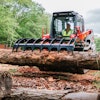



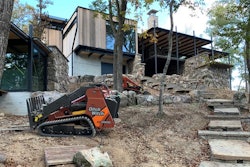
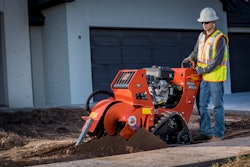
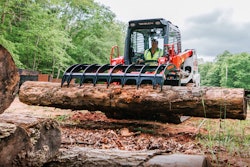







![Doosan Bobcat Wacker Neuson Stack 2ec Js Pb V6e[1]](https://img.greenindustrypros.com/mindful/acbm/workspaces/default/uploads/2025/12/doosan-bobcat-wacker-neuson-stack2ecjspbv6e1.CPyyz8ubHn.png?ar=16%3A9&auto=format%2Ccompress&bg=fff&fill-color=fff&fit=fill&h=135&q=70&w=240)


